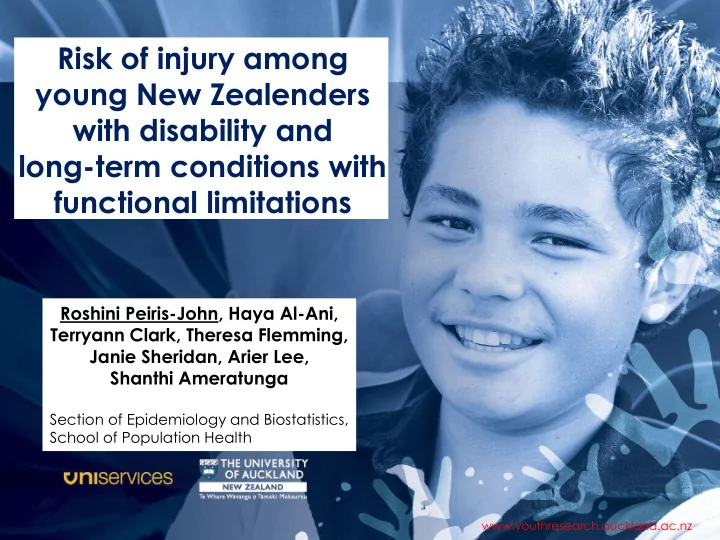

Risk of injury among Youth‘12 National Health and Wellbeing young New Zealenders Survey with disability and long-term conditions with functional limitations Roshini Peiris-John, Haya Al-Ani, Theresa (Terry) Fleming, on behalf of & Terryann Clark, Theresa Flemming, Janie Sheridan, Arier Lee, The Adolescent Health Research Group Shanthi Ameratunga Section of Epidemiology and Biostatistics, School of Population Health www.youthresearch.auckland.ac.nz
Background In New Zealand, one in four people identified as disabled (Disability Survey 2013) 11% of children <15 years (n=95,000) International research suggests people living with disabilities are known to: experience poorer levels of health not have equal access to healthcare Have higher risk of injuries Limited population-based information on injury risks among young New Zealanders with disabilities www.youthresearch.auckland.ac.nz
Aim To investigate the risk of injury and associated healthcare interactions among adolescents living with disabling conditions in New Zealand International Classification of Functioning www.youthresearch.auckland.ac.nz
Method Youth’12 survey National secondary school student survey N=8,500 (response rate - 68%) Self-administered questionnaire using touch screen tablets Students responded to a broad range of questions including: Socio-demographic information Risk and protective factors in home, school and community Health and healthcare interactions www.youthresearch.auckland.ac.nz
Method (cont.) Disabling conditions defined as: Any disability (lasting six months or more) OR Any health problem (lasting six months or more) with functional limitations Difficulty/ inability to carry out every day activities/ other activities that other people of the same age could do Difficulty/ inability communicate, mix or socialise www.youthresearch.auckland.ac.nz
Method (cont.) Analysis Data were weighted and the variance of estimates adjusted. Logistic regression models (controlling for age, gender, ethnicity, home locale and indicators of socioeconomic status) investigated associations between disabling condition and risky behaviour related to road use injury risk: injury requiring healthcare cause of injury problems seeking healthcare for injury www.youthresearch.auckland.ac.nz
Results Youth‘12 National Health and Wellbeing Survey Students with disabling conditions (n=1,267) (15%) Reference population (n=7,233) (85%) Theresa (Terry) Fleming, on behalf of & The Adolescent Health Research Group www.youthresearch.auckland.ac.nz
Results (cont.) Demographic characteristics of study participants Students with Reference population Chi 2 disabling conditions (p-value) n %(95%CI) n %(95%CI) Age <13 221 12.7(11.0-14.4) 1508 87.3(85.6-89.0) 14 282 15.4(13.9-17.0) 1541 84.6(83.0-86.1) 14.571 15 281 16.7(15.0-18.4) 1405 83.3(81.6-85.0) (0.006) 16 257 16.8(14.4-19.3) 1259 83.1(80.7-85.6) >17 225 16.3(14.0-18.6) 1154 83.7(81.4-86.0) Gender 530 14.3(13.1-15.5) 3168 85.7(84.5-86.9) Male 7.815 (0.005) 737 16.6(15.2-17.9) 3706 83.4(82.1-84.7) Female Prioritised ethnicity Maori 255 15.7(13.8-17.5) 1371 84.3(82.4-86.2) 140 12.4(9.6-15.2) 994 87.6(84.8-90.4) Pacific island 32.706 113 11.4(9.1-13.6) 883 88.6(86.4-90.8) (<0.001) Asian 82 16.9(13.1-20.6) 398 83.1(79.4-86.9) Other 676 17.3(16.1-18.4) 3221 82.7(81.6-83.9) European www.youthresearch.auckland.ac.nz
Results (cont.) Socioeconomic characteristics of study participants Students with Reference population Chi 2 disabling conditions (p-value) n %(95%CI) n %(95%CI) NZ deprivation 1 Lower (Decile 1-3) 405 15.3(14.0-16.6) 2233 84.7(83.4-86.0) 0.952 15.9(14.4-17.4) 2415 84.1(82.5-85.6) Medium (Decile 4-7) 460 (0.621) Higher (Decile 8-10) 382 15.1(12.8-17.3) 2153 84.9(82.7-87.1) Worry about not having enough money for food Often/ all the time 211 24.0(20.5-27.6) 658 76.0(72.4-79.5) 56.111 Never/ occasionally 988 14.5(13.4-15.5) 5830 85.5(84.4-86.6) (<0.001) Moved home > twice 113 19.5(16.5-22.4) 472 80.5(77.6-83.4) 6.752 (0.009) <= twice 1153 15.2(14.2-16.3) 6396 84.8(83.7-85.8) 1 NZ Deprivation index 2006 www.youthresearch.auckland.ac.nz
Results (cont.) Risky behaviour related to road use N (%) Adjusted OR Students with Reference (95%CI)* disabling population conditions Risky behaviour related to road use Always wear a helmet while 347(37.0) 1709(34.0) 0.87 (0.75-1.01) cycling (among those who cycle) Always wear a seatbelt 915(72.3) 5118(74.6) 1.12 (0.94-1.35) Risk taking as a driver Driving within two hours of taking 27(4.2) 115(3.6) 1.03(0.62-1.70) >two glasses of alcohol Driving when high on alcohol 26(4.1) 134(4.2) 0.87(0.54-1.39) Driving dangerously 62(9.9) 317(10.0) 0.99 (0.70-1.41) Risk taking as a passenger in a vehicle Driver who was drinking alcohol 272(21.6) 1206(17.6) 1.16(0.96-1.39) Driver was drunk/ taken drugs 151(11.9) 549(8.0) 1.32 (1.04-1.66) Driver driving dangerously 394(23.4) 1124(16.4) 1.43 (1.23-1.66) *Adjusted for age, sex, prioritised ethnicity, worry often about food, moved frequently and NZDep2006 group www.youthresearch.auckland.ac.nz
Results (cont.) Healthcare utilisation for injury N (%) Adjusted OR Students with Reference (95%CI)* population disabling conditions Accessed healthcare for 807(63.9) 3767(55.0) 1.36 (1.22-1.51) injury (previous 12 months) Causes of injury requiring healthcare Road traffic crash 70(5.5) 215(3.1) 1.70(1.24-2.35) Fall 311(24.5) 1187(17.2) 1.46(1.23-1.72) Near drowning 21(1.7) 32(0.5) 3.24(1.83-5.74) Work-related injury 36(2.8) 129(1.9) 1.36(0.98-1.91) Sport or recreation-related 517(41.0) 2582(37.7) 1.10(0.98-1.24) injury Assault 53(4.2) 117(1.7) 2.42(1.67-3.52) Attempted self-harm 87(6.9) 91(1.3) 4.89(3.48-6.86) Difficulty in accessing 187(15.5) 700(10.8) 1.55(1.29-1.85) healthcare for injury *Adjusted for age, sex, prioritised ethnicity, worry often about food, moved frequently and NZDep2006 group www.youthresearch.auckland.ac.nz
Conclusions Adolescents with disabling conditions in New Zealand, attending mainstream schools (cf. with their peers) are at greater odds of: being a passenger in a motor vehicle driven dangerously or by someone who was drunk or taken drugs intentional and unintentional injury experience greater difficulty accessing healthcare for injury when needed More work is needed to identify the physical and social barriers that exist The risks identified require particular attention of healthcare providers, public health workers and policy makers www.youthresearch.auckland.ac.nz
Thank You The Youth’12 project was funded by the Ministries of Youth Development, Social Development, Health, Education and Justice, the Department of Labour, the Families Commission and the Health Promotion Agency (HPA) Thanks to all the schools and students who participated For more detailed information please see our website www.youthresearch.auckland.ac.nz www.youthresearch.auckland.ac.nz
Recommend
More recommend